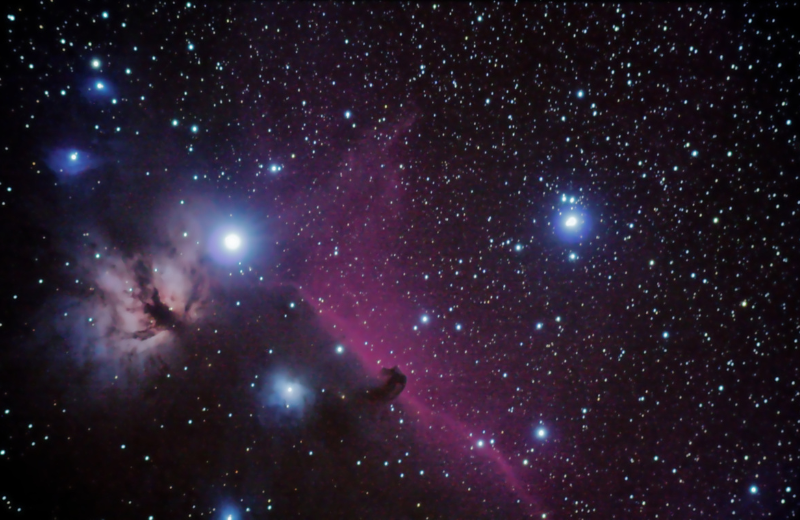The constellation Volans is a lesser-known but intriguing pattern that evokes curiosity with its unique backstory and distinctive shape. Whether you're a seasoned astronomy enthusiast or simply someone who enjoys learning about the stars, this guide shares everything you need to know about Volans, including its distance from Earth and how to observe it in the sky.
Jump to:
Recommended for you!
Best SellersWhat is the Volans Constellation?
Volans is a constellation situated in the Southern Hemisphere, representing a flying fish. The constellation's name comes from the Latin word volans, meaning "flying," which ties into its representation of a fish leaping out of the water. It is one of the 88 modern constellations recognised today and is known for its unique connection to marine life, offering a charming celestial depiction of a creature caught mid-flight between sea and sky.
Although not one of the most prominent or brightest constellations, Volans has a special place in the sky due to its origins and association with early celestial explorers. It was named in the 16th century during a period of intense exploration when navigators used the stars to chart their way across the open ocean. In astronomy, Volans holds significance as part of the constellation family introduced to depict the creatures and instruments found in the Southern Hemisphere.
How Far is the Volans Constellation from Earth?

When discussing the distance of a constellation, it's important to note that the stars making up Volans are at varying distances from Earth rather than forming a cohesive group in space. The stars of Volans range from tens to hundreds of light-years away, with some of its main stars being relatively nearby in astronomical terms. For instance, the brightest star in Volans, known as Beta Volantis, is approximately 107 light-years from Earth.
This varying distance means that while the stars appear to form a pattern from our perspective, they are actually scattered across different regions of space. The arrangement that we see is a product of the position of Earth in the cosmos, with our viewpoint giving Volans its shape.
How Old is the Volans Constellation?
The stars that form the constellation Volans have existed for millions of years, but Volans itself as a recognised pattern in the sky is relatively young. It was first formally introduced in the late 16th century, making it one of the newer additions to the constellation map.
The Volans Constellation Myth

Unlike many of the ancient constellations with roots in Greek or Roman mythology, Volans doesn't have an elaborate mythological tale associated with it. Instead, its story is tied to the Age of Exploration.
The constellation was introduced by Dutch navigators Pieter Dirkszoon Keyser and Frederick de Houtman, who contributed several southern constellations to the night sky. They mapped these star patterns during their sea voyages in the late 16th century, adding marine-themed constellations to represent the new lands and creatures being discovered during that era.
Volans' Stars
Volans may not have the most dazzling stars, but it still features a few interesting ones that form its unique shape. Here are some of the key stars in this constellation:
- Beta Volantis: The brightest star in Volans, Beta Volantis, is a yellow giant located around 107 light-years from Earth. With a magnitude of 3.8, it is visible to the naked eye under dark skies, though it isn’t particularly prominent.
- Alpha Volantis: Another significant star in the constellation, Alpha Volantis, is a white giant situated approximately 124 light-years away. It adds to the constellation's subtle pattern and can be spotted with the help of a clear southern horizon.
- Gamma Volantis: This is a binary star system composed of two stars that orbit each other. Together, they appear as a single point of light to the naked eye, contributing to the faint outline of the constellation.
Nebulae in the Volans Constellation

Volans is home to some interesting deep-sky objects, adding depth to its presence in the night sky. While not as prominent as some constellations like Orion or Scorpius, Volans offers astronomers and stargazers a glimpse at some fascinating nebulae and galaxies. One notable object within Volans is the Lindsay-Shapley Ring, a peculiar ring galaxy known for its striking appearance and complex structure. The galaxy is named after the astronomers who discovered it and provides a stunning example of the diversity of cosmic formations that lie beyond the stars.
Additionally, the constellation borders the more famous Dorado constellation, home to the Large Magellanic Cloud, which extends close enough for some objects to be considered within Volans. This means that Volans is well-positioned for those interested in exploring nearby galaxies and star clusters that enrich this part of the sky.
Finding Volans in the Sky
To catch a glimpse of the Volans constellation, aim to stargaze during the southern summer months, particularly between January and March. During this period, Volans is higher in the sky during the late evening, making it easier to spot.
Locating Volans
Start by finding the nearby constellation Dorado and the bright star Canopus, one of the brightest stars in the night sky. Canopus serves as an excellent reference point, as it’s located close to the region where Volans can be found. Once you've located Canopus, look for the relatively faint stars that form Volans near the constellations Carina and Pictor. The constellation lies low on the southern horizon, so having a clear view in this direction will help.
Viewing Volans with Binoculars or a Telescope
- Using Binoculars: Although Volans' stars may appear faint to the naked eye, binoculars can enhance their visibility, allowing you to trace the constellation's elongated shape more easily.
- With a Telescope: A telescope will provide a clearer and more detailed view of Volans, revealing some of its fainter stars and nearby deep-sky objects.
Best Viewing Conditions
To fully enjoy Volans, find a location with minimal light pollution and a clear, dark sky, ideally on a moonless night. These conditions will maximise your chances of spotting Volans’ subtle star pattern and appreciating its unique celestial charm.
Recommended for you!
Best SellersFun Facts About Volans
- Volans’ Stars Are Diverse in Type: The stars that make up Volans include yellow giants, white giants, and binary systems, showcasing a range of stellar types.
- Named After a Real Creature: Volans is inspired by the real-life flying fish, which are known for their ability to leap out of the water and glide through the air.
- Connected to the Age of Exploration: The constellation was introduced during a time of great maritime discovery, symbolising the link between sea exploration and the stars.
- Not Visible Everywhere: Because it lies in the southern hemisphere, Volans is not visible to observers in northern regions, making it a constellation that many people may never see in person.
Study Astronomy for £29
If you’ve enjoyed this guide to the Volans constellation and want to learn more about the stars, nebulae, and other wonders of the universe, consider studying astronomy in greater depth. Centre of Excellence offers an Astronomy Diploma Course that provides a fascinating introduction to stargazing, celestial objects, and the science behind the night sky. The course is currently available for just £29!












